|
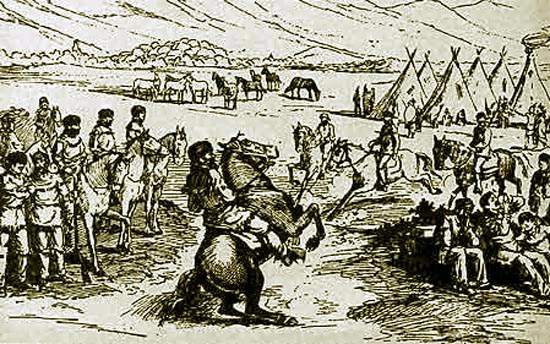
Trou a' Pierre, Pierre's Hole, Rendezvous
The system of rendezvous was established by William Henry Ashley and William Henry with the
Rendezvous of 1825 held near the confluence of Henry's Fork and Burnt Fork at present-day
Burntfork, Wyoming.
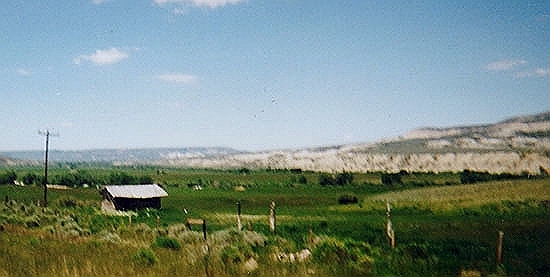 Site of the Rendezvous of 1825, Burntfork, Wyoming. Photo by Geoff Dobson
Site of the Rendezvous of 1825, Burntfork, Wyoming. Photo by Geoff Dobson
The Rendezvous is believed to have taken place in the area behond the first line of trees. Beyong is Burnt Fork. Along the base
of the bluffs is Henry's Fork. The advantage of a rendezvous was that it eliminated the high cost of constructing, manning and maintaining a
line of forts in the upper Missouri. The forts also proved inefficient in that as an area became trapped out,
the forts would no longer be in easy distance for the trappers. The advent of the
rendevous system also eliminated a major expense for the fur companies of salaries for employees known as
"engagés. Trappers were of two types,
engagés and freemen. The engagés could be either mere employees of the company or trappers contractually bound
to sell to the company as a result of the company advancing supplies at inflated prices.
Free trappers outfitted themselves and
could sell whereever they chose and keep the profits for themselves. The trappers who contracted to sell
their furs to the Company received less than freemen. Ashley paid the former $3.00 a pound for the
skins and paid $5.00 to free trappers.
Ashley estimated that some 120 men attended the first rendezvous including 25 deserters from the
Hudson's Bay Company, some 13 to 30 from Etienne Provst, 7 from Jedediah Smith's company, 25 to 30 from John H.
Weber's company and 25 from Ashley men. James Beckwourth, some 30 years later, recalled that there were some 800 in
attendance of which about half were women and children. He also recalled that the "whiskey went as freely as
water, even at the exorbitant price he sold it for." Ashley's inventory did not reflect liquor, a deficiency made up at subsequent
rendezvous. Ashley's prices do seem somewhat high: coffee and sugar $1.50 a pound, tobacco $3.00, powder $2.00, scarlet cloth $6.00 a yard. Blue cloth was
cheaper at $5.00 a yard. But then, it must be remembered the difficulty of getting the goods to the
site. Ashley purchased some 9,000 pounds of peltries at the rendezvous. In St. Louis these would bring almost
$50,000.00. It took his party from July until October to get the furs back going by way of
the Bighorn and Yellowstone Rivers.
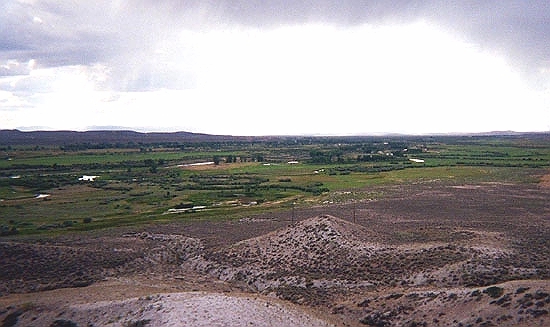
Site of Green River Rendezvous of 1833, near Pindedale, photo by
Geoff Dobson
At the 1833 Rendezvous, a rabid wolf invaded the rendezvous grounds biting twelve of the trappers.
Four died the horrible and agonizing death of hydrophobia, one foaming at the mouth and barking in the
pain. On the return trip along the Bighorn River, one of the men went berserk and dashed into the
woods naked, never to be seen again. Thus, death was not an unnatural or appalling occurance. Such incidents, however,
did not slow down the festivities generated in part by the ready availability of
alcohol which sold for $5.00 a pint. At age 19, Joseph Meek attended his
first rendezvous near present day Lander. Years later, Meek described to
Frances Fuller Victor his distress in witnessing four
seasoned trappers playing a game of cards using the dead body of a compatriot as
the playing surface. Warren Angus Ferris, in the employ of the American Fur Company also
observed the cheapness of life:
A man in the employ of Smith, Sublette and Jackson,
was engaged with a detached party, in constructing one of those subterranean
vaults for the reception of furs, already described.
The cache was nearly completed, when a large quantity of earth fell in upon
the poor fellow, and completely buried him alive. His companions
believed him to have been instantly killed, knew him to be well buried, and the cache destroyed, and therefore left him
Unknelled, uncoffined, ne'er to rise,
Till Gabriel's trumpet shakes the skies,
and accomplished their object elsewhere. It was a heartless, cruel
procedure, but serves to show how lightly human life is held in these
distant wilds.
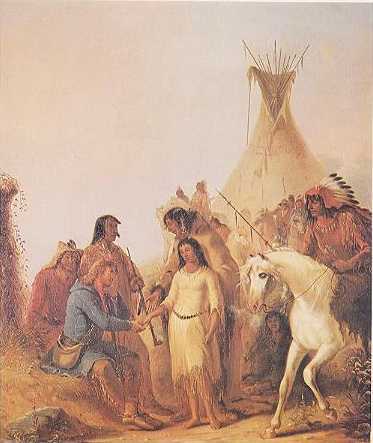
The Trapper's Bride, Alfred Jacob Miller, 1837
Miller indicated that the scene to the left was that of a trapper by the name of Francois who
purchased a bride from her father for $600.00 in trade goods. Since the
goods were brought by wagon from St. Louis, they were necessarily high. A rifle
went for $100.00, horse blankets for $50.00, and flannel for $20.00 a yard.
For discussion of Miller, see Fort Laramie.
Organization for the caravans to the west was difficult. Trade goods had to be acquired. In some instances, companies such
as the Rocky Mountain Fur Company would acquire the stock in trade from suppliers in St. Louis such as
William Henry Ashley. Profits were greater, however, if the goods were acquired directly from
manufacturers or dealers in the east. That meant a trip from St. Louis to Philadelphia or New York to purchase the goods,
transportation of the goods to Pittsburgh and then down the Ohio by keelboat to the
Mississippi, and then up the Mississippi to St. Louis. From St. Louis, the goods were shipped in
the lumbering caravans westward to Wyoming. The American Fur Company which dominated the
upper Missouri would ship its goods up the Missouri by keelboat and in later years by steam packet to Fort Pierre and then
overland to the rendezvous.
The keelboats were from 40 to 75 feet long and 15 to 20 feet wide and were shaped like a pirogue or canoe. Frederick Chouteau who
had a trading post near present day Topeka, described keelboats used by he and and brothers
Cyprian Chouteau and Francis G. Chouteau:
"The keel boat which my brothers had in 1828, I think, was the first which
navigated the Kansas river. After I came the keel boat was used altogether
on the Kaw river. We would take a load of goods up in August and keep it
there until the following spring, when we would bring it down loaded with
peltries. At the mouth of the Kaw we shipped on steamboat to St. Louis.
The keel-boats were made in St. Louis. They were rib-made boats, shaped
like the hull of a steamboat and decked over. They were about 8 or 10 feet
across the deck and 5 or 6 feet below deck. They were rigged with one mast
and had a rudder, though we generally took the rudder off and used a long
oar for steering. There were four row locks on each side. Going up the Kaw
river we pulled all the way; about 15 miles a day. Going down it sometimes
took a good many days, as it did going up, on account of the low water. I
have taken a month to go down from my trading house at American Chief
(or Mission) creek, many times lightening the boat with skiffs; other times
going down in a day. I never went with the boat above my trading house at
the American Chief village. No other traders except myself and brothers
ran keel boats on the Kaw. We pulled up sometimes by the willows which
lined the banks of the river." Kansas, A Cylopedia of State History, Standard Pub. Co., Chicago, 1912.
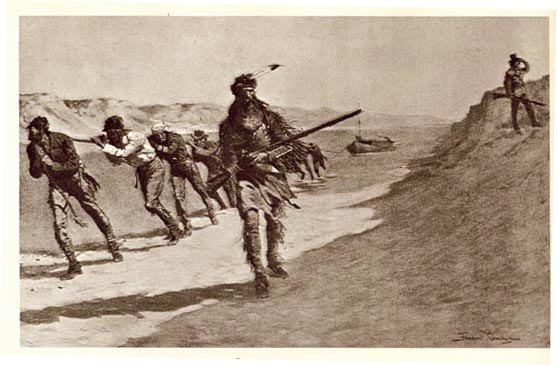
Up-River -- On the Yellowstone, Frederic Remington, Century Magazine, 1901
The above woodcut depicts a keelboat being dragged up the Yellowstone by early fur
traders. The men are using a cordelle, a rope fastened to the mast. The usual method of
ascending river was poling using poles eighteen to twenty feet long. The poles would have a crutch on one end into
which the men would set their shoulder. On the bottom end would be a knob or iron shoe to set against the
river bottom. The men would walk to the stern. When each pair of men reached the stern, they would run back to
the bow and begin the process over again. With a crew of twenty, at any given time 16 would be
walking toward the stern and four returning to the bow. A third method of ascending the river during highwater would be
"bushwwhacking;" that is, pulling on the bushes and willows along the shore.
The goods constituted a veritable department store: cloth, butcher and scalping knives, rifles, mackinaw blankets, vermillion, powder
horns, tools, bridles, Spanish saddles, sugar, ink, paper, quills, flints, calico, flannel, shirts, kettles,
traps, axes, branding irons, wool socks, combs, beads, rope, four, coffee, and, of course,
alcohol. In 1830, as an example, William Sublette carried to the Rendezvous on the Wind River some $30,000 in goods in
ten ox-drawn wagons along with 12 beef cattle and a milk cow.
A license had to be obtained. The alcohol could not, of course, be legally sold to Indians, and, indeed,
importation into Indian country was extremely limited. The process was, however, evaded. Thus, William Sublette obtained
a license for 450 gallons of whiskey on the basis that it was for his "boatmen." In 1832, the American Fur Company was licensed for
1400 gallons of alcohol for "medicinal purposes." Ultimately, the American Fur Company solved the
ban by constructing its own distillery at Fort Union from which it was able to
amply supply the market. The American Fur Company also resorted to old-fashioned smuggling. Hirem Martin Chittenden relates in his
1902 The American Fur Trade in the Far West an 1843 incident in which the
naturalist John J. Audubon assisted the Company in getting the offending booze past a government inspector, Audubon had a government license
for a personal stock of liquor. He used a substantial portion of the private stock to get a young
captain well lubricated so that he would miss the liquor hidden in the hold of the Company's vessel.
Audubon with three assistants was visiting the upper Missouri preparatory to the publication of
his The Viviparous Quadrupeds of North America. The following year, the
Company hid the liquor in barrels of flour ostensibly consigned to the Company's agent Peter Sarpy. To get the
liquor past the inspector, a Methodist minister, the barrels were dutifully unloaded at Sarpy's dock. For some strange
reason, however, after the flour was unloaded, the steamboad did not proceed upstream but remained tied up at
dockside. Curiously, all through the night the captain maintained a full head of steam. In the dark of the night,
the "flour" was reloaded on board. At 3:00 a.m., the reverend inspector received word that something suspicious was afoot at dockside. As he
arrived, the steam packet was making upstream toward Fort Union at full ahead. Others imported the whiskey from Taos.
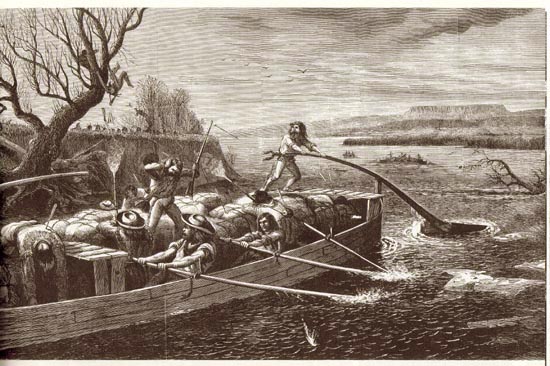
Fur Boat on Missouri, woodcut, Harper's Weekly, 1868, from drawing by W. M. Cary
Once the goods were traded for furs at the Rendezvous, the companies had the difficulty of transporting the pelts back to
St. Louis. In some instances, such as depicted above, the livestock would be driven overland back to
Missouri, while the furs would be transported via Bad Pass to the head of navigation on the Bighorn River near its
confluence with the Yellowstone. There, keelboats used to transport goods to
trading posts on the upper Missouri, or homemade boats would be used to
transport the pelts back to St. Louis. The homemade boats would be of
two types, "mackinaws" or "bullboats." The mackinaw was a wooden boat depicted above. The boat would be divided into four sections by two bulkheads and would be propelled by
oarsmen, The rudder at the rear was steered by a man known as the "patron."
The bullboat was constructed of the hide of buffalo bulls, stretched over a willow frame and made water tight with either pitch or
buffalo tallow and ashes. The bullboat was extremely light and, thus, had a very shallow draft suitable for
navigation in which the river's depth would be measured in inches. Thus, in one instance, in 1835, Robert Campbell was
able to transport hides down the Platte in bullboats when his mackinaw had too great a
draft. The Nineteenth Century humorist Artemus Ward noted of the shallowness of the Platte,
"the Platte would be a good river if set on edge." The bullboats had the advantage that
they could be manned by two men, but had to be taken ashore each night, unloaded, and recaulked.
William de la Montagne Cary (1840-1922) was an artist for a number of magazines, including Harper's and
Leslie's. He learned artwork at an early age from his father and was later apprenticed to an engraver.
In 1861, he headed west by wagon train. Near Fort Benton he was captured by Indians but was
released at the behest of an official with a fur company. Near Ft. Union he took passage on the
steamboat Chippewa, which unfortunately exploded. Cary survived but he lost approximately 80 sketches.
He returned west in 1867 and 1874. Most of his paintings and illustrations were based on a combination of
sketches and memory.
In contrast to the American keelboats, mackinaws and bullboats, the Canadians used Canots du Maitre or Montreal
canoes. The Canadian canoes were 35 to 40 feet long and required 10 or 14 men. The canots could, however, hold some 10,000 pounds.
At the end of Lake Superior, the cargoes would be reloaded into smaller birch bark canoes each capable of
holding 3,000 pounds including a crew of six.
Next page: Rendezvous continued, Jim Bridger, Joseph Reddeford Walker, Moses "Black" Harris.
|